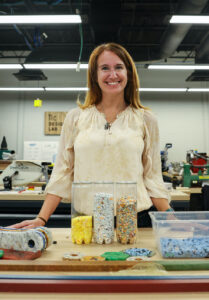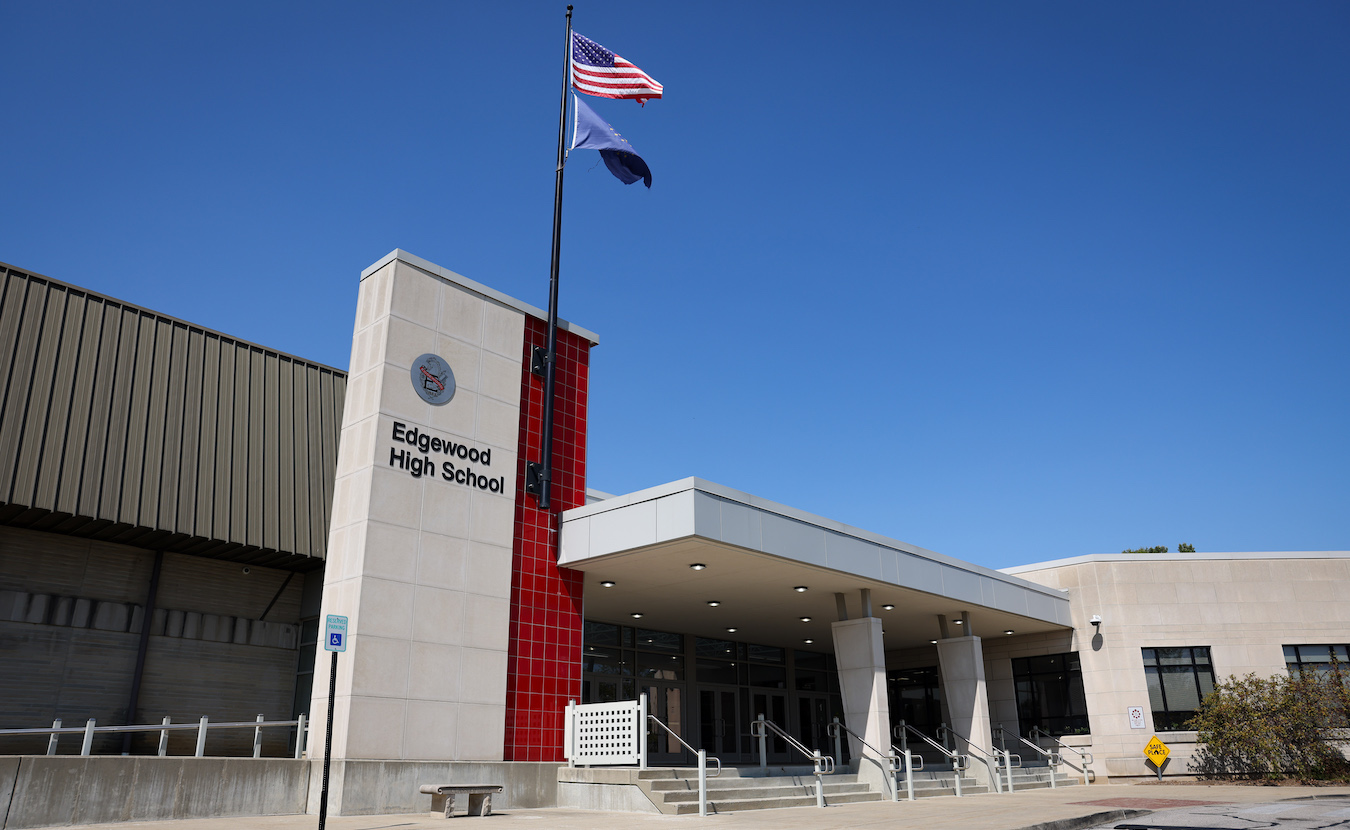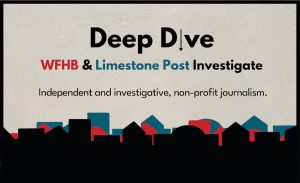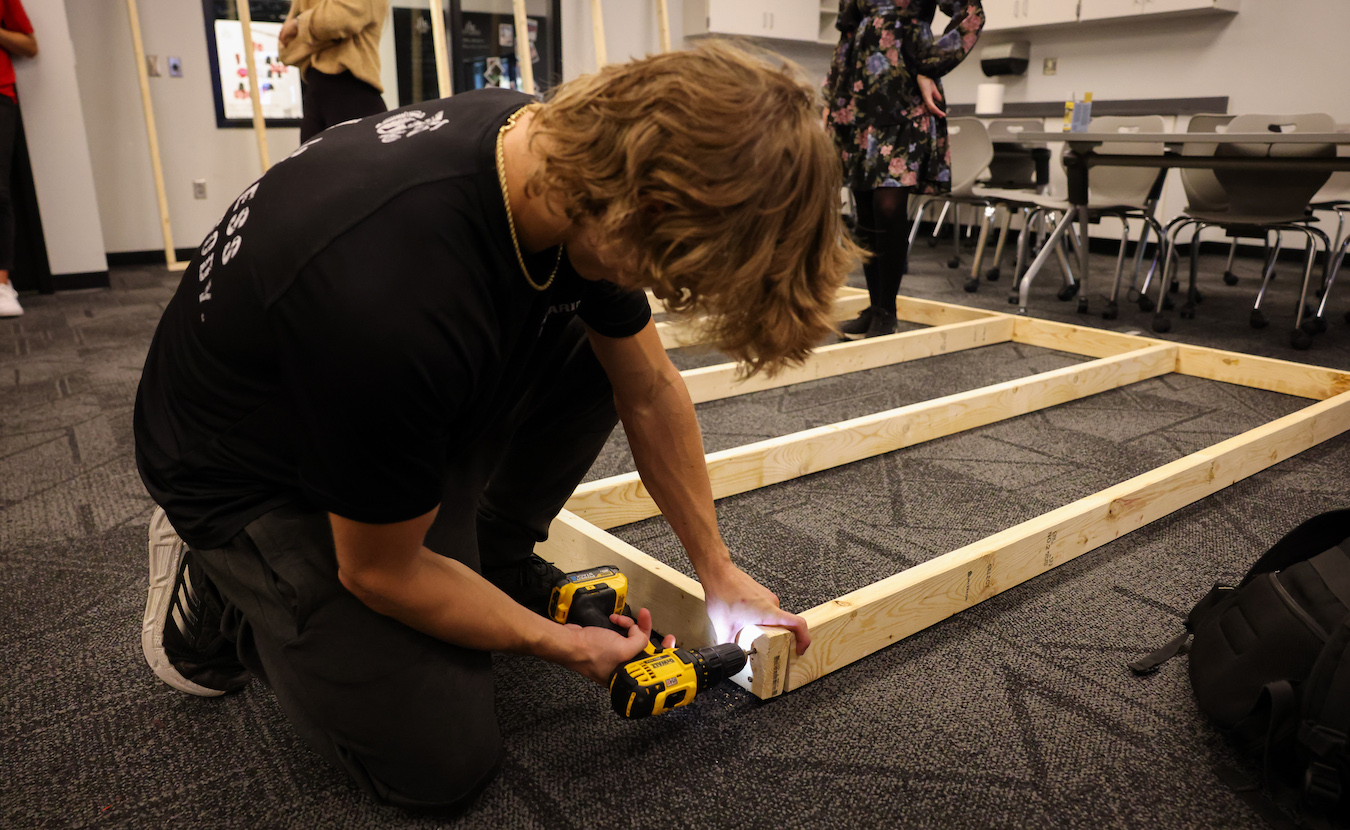Editor’s note: This article is part of the journalism collaboration “Deep Dive: WFHB & Limestone Post Investigate.” Read more about this award-winning series at the end of this article.
[UPDATE: This article has been revised to clarify the different roles played by Ascend Indiana and CEMETS iLab.]
Edgewood High School senior Kaleb Crouch leaves school early every day, gets in his black 2013 Nissan Altima and drives from Ellettsville to Bedford, where he works as an engineering tech for SAIC, one of the nation’s largest defense contractors.

Edgewood High School senior Kaleb Crouch has an apprenticeship in Bedford that gives him real-world experience working with high-tech equipment that will be used at Naval Support Activity Crane. | Photo by Benedict Jones
It’s not your typical after-school job. Crouch is engaged in a modern youth apprenticeship, a combination of schooling with on-the-job training that Indiana policymakers are promoting as the future of career preparation. At age 17, he’s getting real-world experience working with high-tech equipment used at Naval Support Activity Crane and elsewhere.
“It’s still a job,” says Crouch, whose work primarily involves logistics support, “and there are times when you have to do some menial tasks. But there are times when it’s amazing. I can’t imagine other opportunities to get to do what I’m doing right now.”
The job provides hands-on experience and an immersion in the culture of engineering and scientific professionalism that will likely give Crouch a head start on college, where he’s considering studying aerospace engineering.
“I have a lot of options right now,” he says. “Purdue is probably No. 1.”
His apprenticeship is part of UpSkill Work and Learn, a program of Uplands Regional Opportunity Initiatives (Uplands ROI), a regional economic development agency affiliated with the Community Foundation of Bloomington and Monroe County. Edgewood is one of fifteen high schools in Monroe, Brown, Daviess, Greene, Lawrence, Martin, Orange, Owen, and Washington counties participating in the program. In the Monroe County Community School Corporation, the Academy of Science and Entrepreneurship has participated, but BHS North and BHS South have not, at least not yet.

Michi McClaine is vice president of talent development with Uplands ROI. | Photo provided
UpSkill grew out of conversations with students, schools, and employers that found a disconnect between high school classes and graduates’ first experiences in the workplace. “There clearly needed to be a tangible bridge that just wasn’t present,” says Michi McClaine, vice president of talent development with Uplands ROI.
McClaine and career connections specialist Jen Staab manage UpSkill, one of eight apprenticeship “accelerator” initiatives serving 42 Indiana counties. Students apply as high school sophomores. With resume and interviewing assistance from Uplands ROI staff, they compete for positions with participating local employers. And it is a competition.
“The reality is, there will probably, for a while, be more students who are qualified to do this than there are positions for them,” McClaine says.
Apprentices work for the employers ten to twenty hours a week in their junior year and fifteen to twenty hours their senior year. They are paid, typically between $14 and $18 an hour, Staab says. They also take classes that align with their apprenticeships and, in some cases, can lead to certifications that will qualify them for jobs after high school.
Squeezing it all in can be a challenge, but “for some of them, it’s great,” McClaine says. “They’re finally doing something where they’re finding a job that’s interesting and of value.”

Jen Staab is a career connections specialist at UpSkill Work and Learn. | Photo provided
The apprenticeships may extend to a third year, after graduation, when apprentices are in college or working full time. Ideally, employers benefit by establishing relationships with motivated employees who are trained and ready to work.
“The old, traditional approach was ‘This is charity. I’ll help the community out,’” McClaine says. “We’re moving from that to ‘This is part of our talent strategy. We’re building a high-quality talent pipeline, and we can be part of that.’”
At the state level, the apprenticeship push includes business, government, and education partners. Pilot youth apprenticeship programs began in 2019 through funding from Bloomberg Philanthropies, Walton Family Foundation, and others and have been administered by Ascend Indiana, an initiative of Central Indiana Corporate Partnership (CICP).
Brad Rhorer is president and CEO of Ascend Indiana, which spearheads the CICP’s role in building apprenticeship pilots in Indiana. He says apprenticeships can help more high school students find success and direction. Currently, he says, too many students graduate “without a plan,” not focused on college, and unfamiliar with possibilities for training and careers.
“It’s an opportunity to try work-based learning in industry along with pursuing their education at the same time,” he says.

Brad Rhorer is president and CEO of Ascend Indiana, which spearheads the CICP’s apprenticeship initiative. | Photo provided
The youth apprenticeship pilots helped to inform a statewide strategic plan developed by CEMETS iLab, a coalition of nearly 200 leaders from business, education, nonprofit, and government. The plan — which was inspired by the long-established approach to education and job training in Switzerland, where two-thirds of students start apprenticeships at age 15 — calls for 50,000 youth apprenticeships over the next ten years. That would be more than 100 times as many youth apprenticeships as there are today.
“The long-term goal in the strategic plan is to continue to grow and to grow responsibly,” Rhorer says. “We would definitely have to get more industry partners and more education partners on board, but we are on the path.”
Rhorer is optimistic. He says the iLab has taken hundreds of business and government leaders to Switzerland to see how apprenticeships work there, “and they’re coming back ready to support the work. It really is going to be an industry-driven and industry-led opportunity for these kids.”
Others are not convinced. A report this summer by the Indiana Fiscal Policy Institute finds apprenticeships have some promise as a training model but “scaling these programs to meet the needs of Indiana’s 21st century economy will be challenging.” It notes that U.S. apprenticeships have low completion rates, under 40 percent, and that there is no evidence of “sufficient organic employer demand” for apprentices in Indiana.
Others point out that Indiana, unlike Switzerland, doesn’t have a robust public transportation system to get students to and from work, and that businesses that want to hire apprentices are likely to be few and far between in some rural areas.

Count Michael Hicks among the skeptics. Hicks, the George and Frances Ball Distinguished Professor of Economics at Ball State University, doubts that American businesses, which are notoriously bad at training their own workers, will want the cost and responsibility of a scaled-up system of apprenticeships.

Michael Hicks is the George and Frances Ball Distinguished Professor of Economics at Ball State University. | Photo provided
“It’s fine for businesses to wistfully say they’d like to fund this,” he says. “I don’t see any evidence they’re putting their money where their mouth is.”
Hicks, who has studied workforce issues in the United States and Europe, says the Swiss system has been criticized for locking students into educational and career choices at an early age. Unfamiliar with other options, students are likely to follow in their parents’ footsteps.
“Who your parents and grandparents are is going to be more highly predictive of your educational outcomes than most Americans would feel is acceptable,” he says.
Hicks says Indiana’s real workforce problems stem from underfunding K–12 education — Switzerland spends about twice as much per pupil — and failing to prepare students for college, when 81 percent of jobs created in the past 30 years require a degree. The number of Hoosier students who enroll in college has declined from 65 percent to 53 percent in the past decade.
Likewise, Hicks says, anyone who thinks students should commit to a career path when they’re starting high school clearly hasn’t spent much time around 15-year-olds. Making them do so, he believes, would worsen existing problems with student engagement.
“I’ll just be brutally frank,” he says. “This is what happens when a group gets together and tries to solve a problem without understanding it. They jump on the first interesting-sounding solution, and they push for it.”
“
The number of Hoosier students who enroll in college has declined from 65 percent to 53 percent in the past decade.
”
Indiana legislators have promoted apprenticeships and work-based learning as part of “reinventing high school” to make it more relevant to students. The slogan also encompasses a controversial redesign of high school diploma requirements and state funding for voucher-like career scholarship accounts to pay for job training.

Jennifer Barrett is director of teaching, learning, and ready schools for the Richland-Bean Blossom Community School Corporation. | Photo by Benedict Jones
In fact, many schools have been reinventing themselves without a state mandate.
“This has been a movement for the last ten years,” says Jennifer Barrett, director of teaching, learning, and ready schools for the Richland-Bean Blossom Community School Corporation, which includes Edgewood High School. “It’s nothing new. But what is happening now is, they’re opening doors for us to take it further.”
Barrett, a former elementary school principal, says R-BB teachers and administrators began making changes to help meet local workforce needs several years ago, helped by a Ready Schools grant from Uplands ROI. Edgewood vastly expanded its number of academic pathways, course sequences that align with career areas. It also jumped into work-based learning for students who want it. It has a dozen students doing UpSkill apprenticeships with area employers such as SAIC, MSP Automation, Smithville, and German American Bank. It also has several times that many students doing in-house internships and apprenticeships, some paid and some unpaid, or working at student-run businesses, including a coffee shop and a marketing agency.
“We started thinking about, how do we create additional career pathways,” Barrett says, “so it’s about testing out what students might want to do, not about checking a box for a diploma.”
Barrett says creating more work-based learning opportunities will benefit students who won’t enroll immediately in college. Students chosen for UpSkill apprenticeships, she says, “are students who have a plan, and it’s four years of college, usually.”

Kaleb Crouch | Photo by Benedict Jones
That’s certainly true of Kaleb Crouch, the son of an auto body repair estimator and a medical billing director, whose interest in math and science led to an affinity for engineering. Along with loading his abbreviated school schedule with dual-credit classes, he’s savoring the experience of being part of a high-tech, professional workplace, practicing communication skills, and being part of a team. And the fact that the apprenticeship is paid doesn’t hurt.
Because he passed on employer-sponsored health benefits, Crouch makes $20 an hour. He used his earnings to pay most of the cost of a month-long study-abroad program in southern Spain.
“Having that experience alone changed my life,” he says. “I definitely see things in a different way now.”

Edgewood High School vastly expanded its number of academic pathways and also jumped into work-based learning for students who want it. It has a dozen students doing UpSkill apprenticeships with area employers such as SAIC, MSP Automation, Smithville, and German American Bank. | Photo by Benedict Jones
 Deep Dive: WFHB & Limestone Post Investigate
Deep Dive: WFHB & Limestone Post Investigate
The award-winning series “Deep Dive: WFHB and Limestone Post Investigate” is a journalism collaboration between WFHB Community Radio’s Local News Department and Limestone Post Magazine. Deep Dive debuted in February 2023 as a year-long series, made possible by a grant from the Community Foundation of Bloomington and Monroe County. The Community Foundation also helped secure a grant from the Knight Foundation to extend the series for another year.
In the series, Limestone Post publishes an in-depth article about once a month on a consequential community issue, such as housing, health, or the environment, and WFHB covers related topics on Wednesdays at 5 p.m. during its local news broadcast.
In 2023, Deep Dive was chosen by the Institute for Nonprofit News as a finalist for “Journalism Collaboration of the Year” in the Nonprofit News Awards held in Philadelphia. And this year, the series brought home seven awards from the “Best in Indiana” Journalism Contest by the Society of Professional Journalists. Read more about the awards.
Here are all of the the Deep Dive articles and broadcasts so far:
Housing Crisis
Limestone Post article by Steve Hinnefeld, published February 15, 2023:
Deep Dive: Struggling with Housing Supply, Stability, and Subsidies, Part 1
WFHB reports:
Steve Hinnefeld won 1st place for “Non-Deadline Story or Series” in the Indiana Pro Chapter of the Society of Professional Journalists “Best in Indiana” Journalism Contest for parts 1 and 2 of this housing series. The staff of WFHB won 2nd place for “Coverage of Social Justice Issues” for its programs “Deep Dive: Housing Crisis.”
Housing Crisis Solutions
Limestone Post article by Steve Hinnefeld, published March 15, 2023 | photography by Jim Krause
‘No Silver Bullet’: Advocates, Officials Use Many Tactics on Housing Woes
WFHB reports:
Opioid Settlement Fund Investigations
Limestone Post article by Rebecca Hill, published April 12, 2023 | photography by Benedict Jones
How Will Opioid Settlement Monies Be Spent — and Who Decides?
WFHB reports:
IU Tree Inventory
Limestone Post article by Laurie D. Borman, published May 17, 2023 | photography by Jeremy Hogan
Trees Do More Than Add ‘Charm’ to IU Campus
WFHB reports:
Indiana Power Grid
Limestone Post article by Rebecca Hill, published June 21, 2023 | photography by Benedict Jones
The Power Struggle in Indiana’s Changing Energy Landscape
Rebecca Hill won 1st place for “Medical or Science Reporting” in the Indiana Pro Chapter of the Society of Professional Journalists “Best in Indiana” Journalism Contest for this article.
WFHB reports:
Lake Monroe Survival
Limestone Post article by Michale G. Glab, published August 16, 2023 | photography by Anna Powell Denton
How Healthy Is Lake Monroe — and How Long Will It Survive?
Michael G. Glab won 3rd place for “Business or Consumer Affairs Reporting” in the Indiana Pro Chapter of the Society of Professional Journalists “Best in Indiana” Journalism Contest for this article.
WFHB reports:
Indiana Lawmakers Attack Public Schools
Limestone Post article by Steve Hinnefeld, published September 13, 2023 | photography by Garrett Ann Walters
Local Parents, Educators Face ‘Attack’ on Public Schools from Indiana Lawmakers
WFHB reports:
On Saving the Deam Wilderness
Limestone Post photo essay by Steven Higgs, published October 18, 2023
On Saving the Deam Wilderness and Hoosier National Forest | Photo Essay
Steven Higgs won 2nd place for “Multiple Picture Group” in the Indiana Pro Chapter of the Society of Professional Journalists “Best in Indiana” Journalism Contest for this photo essay.
WFHB reports:
Food Insecurity, Part 1
Limestone Post article by Christina Avery and Haley Miller, photography by Olivia Bianco, published December 18, 2023
One Emergency from Catastrophe: Who Struggles with Food Insecurity?
Christina Avery and Haley Miller won 1st place for “Coverage of Social Justice Issues” in the Indiana Pro Chapter of the Society of Professional Journalists “Best in Indiana” Journalism Contest for this article.
WFHB reports:
Food Insecurity, Part 2
Limestone Post article by Christina Avery and Haley Miller, photos by Olivia Bianco, published March 13, 2024
‘Patchwork’ of Aid for Food Insecurity Doesn’t Address Its Cause
WFHB report:
What’s at Stake in the Debate Over Indiana’s Wetlands
Limestone Post article and photos by Anne Kibbler, published May 15, 2024
What’s at Stake in the Debate Over Indiana’s Wetlands?
WFHB reports:
- Wetlands (Part 1), May 22, 2024
- Wetlands (Part 2), May 29, 2024
- Wetlands (Part 3), June 7, 2024
- Wetlands (Part 4), June 12, 2024
Resilience Amid Hardship: Refugees Find Challenges, Opportunities in Bloomington
Limestone Post article by Brookelyn Lambright, Karl Templeton, and Brenna Polovina from the Arnolt Center for Investigative Journalism, published August 1, 2024
Resilience Amid Hardship: Refugees Find Challenges, Opportunities in Bloomington
WFHB reports:
- Refuge in Indiana (Part 1), August 7, 2024
- Refuge in Indiana (Part 2), August 14, 2024
- Refuge in Indiana (Part 3), August 21, 2024
- Refuge in Indiana (Part 4), August 28, 2024
Apprenticeships Work for Some High School Students But Not All
Limestone Post article by Steve Hinnefeld, photography by Benedict Jones, published September 24, 2024
Apprenticeships Work for Some High School Students But Not All
WFHB reports:
- Apprenticeships (Part 1), October 9, 2024
- Apprenticeships (Part 2), October 16, 2024
- Apprenticeships (Part 3), October 30, 2024
Goal of BPD and Social Support Team Is ‘To Help People’
Limestone Post article by Haley Miller, published November 26, 2024
Goal of BPD and Social Support Team Is ‘To Help People’
WFHB reports:
- Police and Social Work, January 29, 2025
- Police and Social Work (Part 2), February 5, 2025
- Police and Social Work (Part 3), February 26, 2025
Political Polarization Hurts Communities — What Can Be Done?
Limestone Post article by Marjorie Hershey, photos by Jeremy Hogan/The Bloomingtonian, published January 26, 2025
Political Polarization Hurts Communities — What Can Be Done?
WFHB reports:
- Political Polarization, (Part 1), March 19, 2025
- Political Polarization, (Part 2), March 27, 2025
- Political Polarization, (Part 3), April 2, 2025
Mental Health Issues Are Increasing Dramatically Among Hoosier Youth
Limestone Post article by Rebecca Hill, photography by Benedict Jones, published April 3, 2025
Mental Health Issues Are Increasing Dramatically Among Hoosier Youth
WFHB reports:





